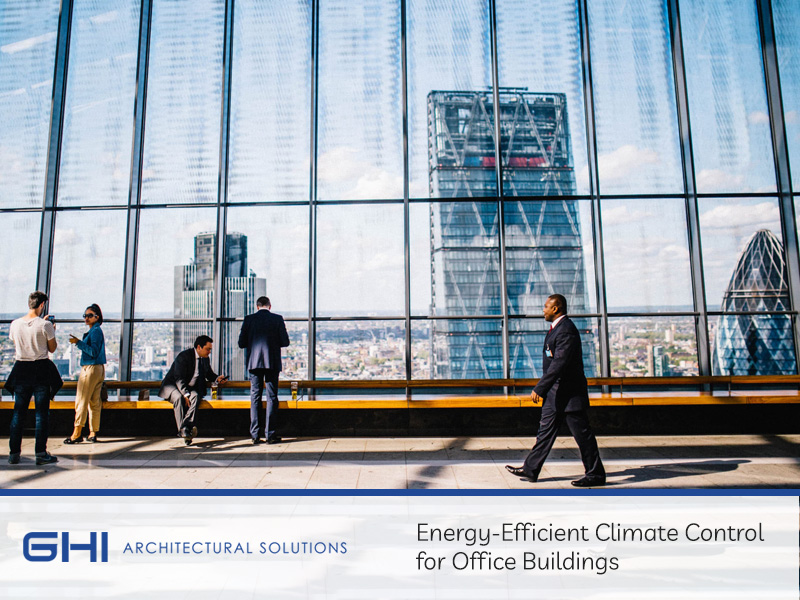Energy-Efficient Climate Control for Office Buildings
When we talk about climate control for offices or other commercial buildings our minds likely go to the energy efficiency of their HVAC systems. Certainly, this is a major factor.
However, as the building industry explores the many-faceted topic of green buildings, we see that there are multiple factors that affect their energy efficiency, not least of which is the design and materials used.
To this end, aluminium curtain walling is experiencing a surge of interest as the construction industry realises its enhanced energy efficiency and environmental benefits.
The primary purpose of curtain walls is to protect the interior of a building from external elements. We are particularly interested in aluminium curtain walling as it relates to interior environmental control in commercial buildings.
The Challenge of Climate Control

HVAC systems have been the go-to climate control solution for decades. While the systems themselves have experienced significant eco-friendly changes over the years, they remain one of the biggest energy expenses in commercial buildings.
Energy costs, especially here in South Africa, have soared which forces property owners, architects, and builders to investigate alternatives to the energy-hungry HVAC units.
This has been one of the main drivers behind the growth of aluminium curtain walls.
Reducing the Load on HVAC
Curtain walls serve to stabilise the internal temperature of a building. The glazing is usually made up of two or more panes separated by an inert gas such as argon or krypton.
This barrier efficiently keeps the outside weather from affecting the internal climate, keeping the cool in and the hot out, or vice versa. The HVAC units, therefore, don’t have to work as hard or as long to maintain a comfortable temperature which reduces the energy costs for the building.
However, it’s worth noting that in particularly warm and sunny locations, the choice of glazing will be the main factor dictating the efficiency of the curtain wall.
Protection from the Elements
The insulating properties of aluminium curtain walls further assist in keeping moisture and pollution out of a building. We tend to experience extremes of weather here in South Africa and excessive heat, below zero, high winds, and thunderstorms are to be expected.
A curtain wall acts as an additional barrier to these elements, enveloping and protecting the building. Occupants need not concern themselves with water damage or damp, city pollution, or other elemental effects.
It’s been found that a well-designed curtain wall offers a degree of structural protection from the wind, especially for taller buildings. This smooth, wide surface area assists in distributing lateral wind forces which spreads the load.
Additional Benefits
Curtain walls are not structurally part of a building therefore they can be installed as a renovation project to an existing structure. They offer a beautiful transformation of the external façade of a building being modern and sleek. They have also been used to modernise and protect buildings while still highlighting the beauty of the original architecture.
Curtain walls allow more natural light into a building which is widely accepted as a healthier option than artificial light for occupants. Again, lower energy costs result from the reduced lighting requirements.
CPNI adds, “A curtain wall may contain specific architectural features designed to enhance the appearance of the building or elements intended to manage the effects of the environment. Such features may include brise soleil and external fins designed to provide shading or photo-voltaic panels capable of generating electricity.”
Why Choose Aluminium?
Aluminium has entrenched itself as a strong and recyclable material – both of which are necessary and sought after in the construction industry.
The strength of aluminium allows for narrow, aesthetically pleasing frames that are still able to support a larger expanse of glass. In fact, it’s this very aspect that allows for innovative designs from enterprising architects.
It requires very little maintenance and in a curtain wall system, can effectively reduce the life-cycle costs of a building. Aluminium can be powder coated and treated in dozens of ways which allows designers to work with a company’s branding or simply to make a statement.
Work with GHI
We appreciate that the range of choices along with their advantages and disadvantages can take some time to absorb. That is why we work closely with architects, designers, and builders to unpack the best option for their needs.
If your next project requires aluminium curtain walls, then we can certainly assist you. Please call 011 608 2800.

